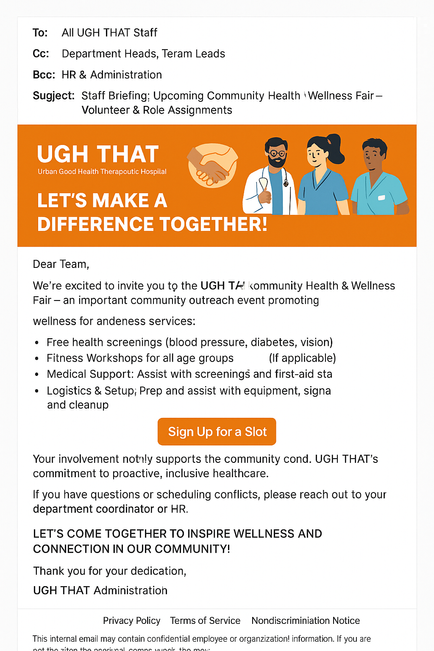Personalization beyond the AJO Profile: Bringing non-Profile personalization into AJO email templates
AJO’s standard profile-driven personalization is not sufficient for managing common, frequently updated template components—such as internal compliance notices, member disclosures, or branded language—that are not part of the individual profile but must be inserted based on the context (internal/external), campaign type, or data source. This blog delivers a practical guide for institutions aiming to dynamically inject header/footer blocks into AJO email templates.
Use Case:
For the upcoming Community Health & Wellness Fair, UGH hospital needs to deliver targeted email communications through Adobe Journey Optimizer (AJO) for both internal staff and external community members at the same time. Internal employees require emails with dynamic header, footer, or informational blocks specific to their roles (such as booth assignments, volunteer sign-up links, and facilitation reminders), while external recipients (local residents, past patients, and partner organizations) need invitations, event details, and registration calls to action—all potentially with distinct disclaimers or event-specific banners.
AJO’s built-in personalization primarily focuses on profile data. How can we efficiently introduce, manage, and scale non-profile content—like custom headers, footers, or program highlights—so that email templates dynamically adapt to the audience type, ensuring volunteers receive operational guidance while community members receive welcoming invitations?
Step-by-Step Guide: Dynamic Email Personalization for UGH Community Health & Wellness Fair
1. Template Preparation: Dynamically Managing Headers and Footers
Create Fragments:
- Navigate to Content Management → Fragments in AJO.
- Click Create Fragment and give it a clear name (e.g., "Header_Internal_Disclaimer" or "Footer_External_HIPAA").
- Add relevant HTML, branding, or compliance language to the fragment.
- Click Save.
Design Email Templates Using Fragments:
- Go to Content Management → Templates and create a new email template.
- In the visual editor, use the Fragments icon to drag your desired headers/footers into the template.
- For staff-facing emails, use fragments like "Header_Internal" and "Footer_Internal".
- For community recipients, use "Header_External" and "Footer_External".
- Add core message content as needed.
- Save your template with descriptive names, such as “Member Email Template (External)” or “Staff Email (Internal).”
Using Conditional Content and Parameterized Fragments in Email Templates (for complex use-cases)
Conditional content allows you to tailor messaging for recipients based on their type, role, or other journey-specific attributes. This ensures the right information reaches the right audience within a single, reusable template.
1. Role-based Messaging (for Hospital Staff)
Provide customized instructions based on the internal recipient’s role, such as reminders for facilitators and sign-up info for volunteers. This ensures each staff member receives clarity on their duties or event logistics according to their assignment.
{%#if profile.person.type = "facilitator" %}
<div>Reminder: Please oversee session A, and check in volunteers by 9AM.</div>
{%else if profile.person.type = "volunteer" %}
<div>Your volunteer sign-up and booth details are below.</div>
{%else%}
<div>General participant instructions here.</div>
{%/if%}2. Dynamic Disclaimers/Banners
Present legally required disclaimers and event banners only to external audience members. This provides the right compliance and participation messaging for public recipients, while keeping internal communications focused.
{%#if userRole = "admin" %}
<div class="admin-message">You have administrative access. Manage system settings here.</div>
<img src="admin_banner.jpg"/>
{%/if%}Parameterized fragments allow you to insert adaptable, reusable content blocks within your template that adjust based on supplied values, supporting both internal and external communication requirements
1. Event Info Fragment (with parameters)
This fragment gives all recipients the event basics, while the fragment content can be uniquely tailored for each group e.g., staff-only logistics or public CTAs.
{{fragment id="eventDetails"
eventName=event.name
eventDate=event.date
location=event.location
contact=event.contact
}}2. Booth Assignment (for Staff Only):
Shares individualized booth info or logistics only with staff, keeping recipient experience relevant and uncluttered.
{%#if recipientType = "internal" %}
<!-- Fragment or content block should be inserted by the design tool-->
{{staffRole}} - {{staff.booth}}
{%/if%}
2. Journey Setup: Drive Context for Header/Footer Selection
Orchestrate the journey to set the correct context or choose the right template for internal vs. external recipients.
Create a New Journey:
- Go to Journeys and click Create Journey.
- Name the journey appropriately, e.g., “Community Health & Wellness Fair Announcement.”
Add Audience Split Condition
Using Journey Branches (Segment Split):
- Add a Read Segment activity.
- Configure “INTERNAL” and “EXTERNAL” branch logic based on:
- An imported segment
- Or Event payload logic
- Or profile pseudo-field
3. Add Email Step with Targeted Template
In the internal branch, select the “Staff Email (Internal)” email template (or template with audienceType=internal context).
In the external branch, select the “Member Email Template (External)” email template (or template with audienceType=external context).
4. Go Live and Monitor
Activate the journey and based on the type of person type, Internal and External emails will be triggered.
Conclusion
In today’s dynamic communication environment, delivering the right message to the right audience is more important than ever. With tools like Adobe Journey Optimizer, organizations can efficiently manage, personalize, and optimize email content at scale—ensuring consistent branding, compliance, and relevance.
By combining reusable fragments, dynamic templates, and intelligent journey orchestration, teams can streamline content management and adapt quickly to changing needs. Embracing these best practices empowers you to maintain high-quality communications, build stronger connections with your audiences, and drive success across every touchpoint.
커뮤니티
- 커뮤니티 홈
- 가이드라인
- 커뮤니티 어드바이저
- Experience League Showcase
- Advertising
- Analytics
- Audience Manager
- Campaign Classic v7 & Campaign v8
- Campaign Standard
- Developer
- Experience Manager Sites & More
- Experience Platform
- Journey Optimizer
- Target
- Community Announcements
- Real-Time Customer Data Platform
- Workfront
- Marketo Engage
- Commerce
- Creative Cloud
- Document Cloud










여기에 의견을 추가하려면 등록된 사용자이어야 합니다. 이미 등록되어 있다면 로그인하시기 바랍니다. 아직 등록하지 않은 경우 등록 후 로그인하시기 바랍니다.